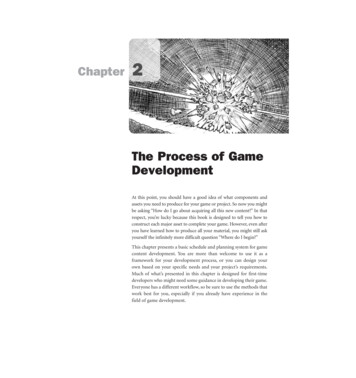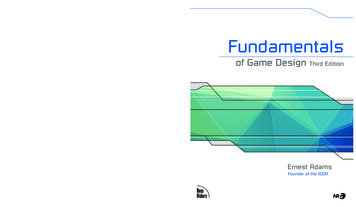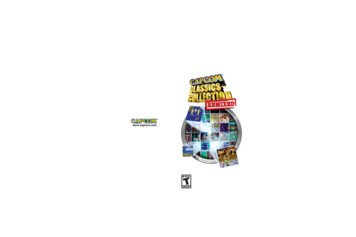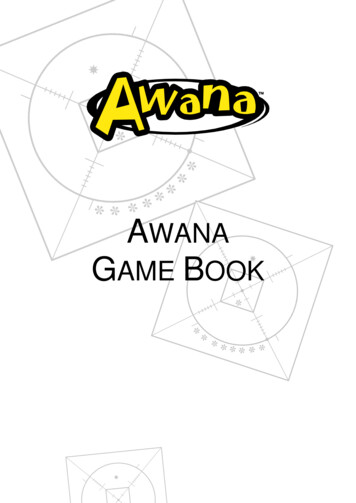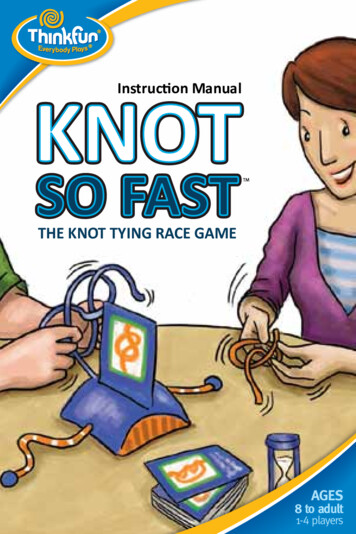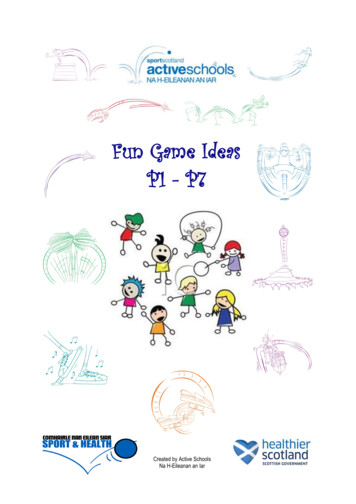
Transcription
Fun Game IdeasP1 - P7Created by Active SchoolsNa H-Eileanan an Iar
IntroductionThis booklet has been designed to provide teachers, volunteers and coaches with additional ideasfor games and activities within a school, playground or club setting.The games listed within this booklet have been broken into four sections - Warm Up Activities, MainActivities, Cool Down Activities & Parachute Games. Within the description of the games pleaselookout for the box specifying which group the activity would be best suited to. However these aresimply suggested guidelines and can be adapted to suit various ages, games and activities. .At the bottom of each game description you will find a comments box. This is the perfect opportunityto take notes on the games played. This could be anything from what worked well, or what might bedone differently, how to make it more challenging or simpler. By doing this you may also create yourown game!Active Schools also has a wide range of resources, games and activities available online. Pleasefeel free to take a look and try out some of the games within the resource pages. If you would likemore information on any of the games or the booklet please do not hesitate to contact your ActiveSchools Coordinator.Active Schools online: www.cne-siar.gov.uk/activeschools2Iain GG CampbellSports DevelopmentServices ManagerWestern Islesiain.campbell@cne-siar.gov.uk01851 822782Jenna StewartActive SchoolsCo-ordinatorHarris & Westsidejenste@cne-siar.gov.uk01851 822783Eric MacleodActive SchoolsCo-ordinatorGreater Broadbayeric.macleod@cne-siar.gov.uk01851 822784Christine MacQuarrieActive k01870 603591Katie DenehyActive SchoolsCo-ordinator (P/T)Barrakatiedenehy@cne-siar.gov.uk01871 810471
Warm UpActivities3
Why do we warm up?“The main reason for using warm ups is to minimise risk of injury. Warm ups also serve to enhance the physiological and physiological preparedness for the activity.” (Byl, J. 2004)An effective warm up should: Gradually increase HR and blood circulationIncrease body temperatureImproves efficiency of muscular actionsPrepares the joints & associated muscles to function to their full Range of Movement (RoM)Adds psychological preparation for activity to followWhat you could ask children during the warm up: Why do we warm up?How are you feeling – hot, sweaty, out of breath?Why do we sweat?If you touch your skin, how does it feel?Heart rate, is it fast or slow? Blood pumping round your body getting you ready to take part insport/games.Where can you feel your heart beat (pulse) – chest, neck, wristAre you ready?!Length of Warm Up Should not exceed 10 to 15 minutesThings to considerRecommendation is for no static stretching during warm ups. Stretches should be dynamic, e.g. highknees, heel flicks, arm swings, touching ground while walking / runningIntroduce elements of main activity in warm up where appropriate, e.g. arms and shoulders if throwinginvolved; build up running speed if sprints are involved.Involve all children in whole warm up.4
Cups and Saucers(Agility, Balance, Coordination)Split the group into two teams (depending on numbers). Have each group stand at either end of thehall. In middle of the hall, spread out cones, some sitting the correct way to make ‘saucers’, and others upside down to make ‘cups’. When the leader shouts “GO” the children must run into the centreof the hall. One team will be turning the cups into saucers, and the other team will be turning saucers into cups. Give the group 20 seconds or so to see how many cones they were able to turn.The team who turn the most cones win.Coaching Points: Encourage children to stay on their feet Ensure children move around and don’t not stay in one area turning over the same cones.Notes:Why not give children a challenge. I.e they can only turn over a certain colour or decrease the timeallocated to turn over cones. Have more than one game going at once - split the hall in half.To clear up the cones when the game is complete, introduce a mini competition to see who can collect the most cones.Suitable age: P1—P7Line Tig / Pac-Man(Running, Agility, Balance)Using the lines of a badminton court, the coach selects one child to be a catcher or Pac Man/Girl.They must then try and catch the other children - however they all must follow the lines of the court.If a child is caught 3 times they block the route at the point they were caught, and sit on the line holding onto their knees as a ‘road block’. This is fast pace walking activity.Notes:Suitable age: P1—P75
Rock Paper Scissor(Running, Agility)Select two teams. Have them facing each other in a line around 5 feet apart. As a group they selecteither rock, paper or scissor. Once each team has selected their item, they return to line, and faceone another. They then hold out only one hand and make a fist. Both teams then say together “1, 2,3” and both teams show their selected item. The team who win must then chase the other team andtry to catch them before they cross their safety line which is located behind them roughly 10 pacesaway. If caught, they join the other team.Notes:Suitable age P5—P7Shark Attack(Running, Coordination)One catcher is a shark, the rest are swimmers. Spread a number of hoops around the hall, whichare islands. The children jog (swim / surf / water ski) around the hall, and around the hoops. Theshark swims around also, with their hands on their head, in the shape of a fin. When the coachshouts ‘Shark Attack!’ the swimmers must get onto an island before begin caught by the shark. Ifany swimmers are caught they then become a shark. You can also limit the number of people to anisland as an added challenge, and you can pick up the islands, and then throw then down after youyell ‘shark attack’ so pupils don't congregate round hoops.Notes:Suitable age P1—P76
Pirate Ships(Agility, Balance, Running)Assign each wall as either N,S,W,E. When the coach shout out a direction ie North, children mustrun to that wall as quickly as possible. You can introduce the following actions to make it a littleharder as they have to remember a number of actions! If the hall is too big, mark a square out withcones.Scrub the Decks – Children fall to their knees and pretend to scrub the floor.Climb the Rails – Children pretend to climb railsCaptains Wife – Children put their hand on their hips and move in a circular motion while saying –whoot whooCaptains Cook – Children pretend to be sickCaptains Coming – Children salute and say “Aye Aye Captain”Walk the Plank - Children have to walk in a perfect straight line one foot exactly in front of the otherwith arms outstretched to the sidesPeg Leg Jim – children hop on one legNotes: For lower primary pupils, instead of using N,S,E,W, place a colour cone at each wall, andcall the colour.Suitable age P1—P7Stealers(Running, Coordination)Split the children into four teams and have each team sit in a straight line, one behind the other.Number each person in the team from 1 – 5 for example. Make a square with 4 cones (like No. 4 ondice). Each team sits behind a cone with a hoop in front of them, facing the centre of the square. Inthe centre of the square, place another hoop, filled with bean bags. When ready, call out a numberat random. That number, from each team will then run to the centre of the square and collect ONEbean bag. They then run back to their hoop and place (NOT THROW) it into the team hoop. Thesame number keep going until a team gets 3 beanbags first. On the second attempt, call anothernumber at random (or you can call out sums, ie 2 2, therefore number 4 would run). This time theycan take from the middle hoop, and steal from other teams hoops to prevent them from getting 3before anyone else. Ensure those sitting keep their hands away from the hoop.Notes:Suitable age P4—P77
Farmers & Rabbits(Running, Coordination)Select two catchers (farmers). Their aim is to catch the other children who are rabbits. The rabbitstuck a bib into the top of their t-shirt or at the top of their shorts. The farmers then have to catch therabbits by pulling out their tails. If a rabbits tail is stolen, the farmer gives it back to the rabbit. Tellthe children a story about rabbits have been cheeky how they have been stealing the farmers carrots. This always makes them giggle!Farmers can also collect the bibs during the last game instead of returning them. This is a good wayof tidying up. You could also get the farmers to collect the bibs and place them into a hoop in thecorner of the room each time they catch a ‘tail’. You can then make this into a challenge and see ifany other farmers can beat the record made by the previous farmers.Notes:Suitable age P1—P7Tails(Running, Coordination)All children tie a small braid / bib (the tail) into the side or back of their shorts, or at the top of their tshirts. The object of the game is for the child to try and not lose their tail, but at the same time tryand catch someone else’s tail. If a child loses their tail, the catcher returns it to them in their hands(so as to ensure nobody slips on a bib on the floor). To finish the game, change the rule so that thistime if their tail is stolen, they sit down & the game will carry on until the end when we find out whohas the most tails.Notes: We would only make children sit down or go ‘out’ during a game at the end of a game / session to ensure all pupils are included and active.Suitable age P1—P78
Late for School(Coordination)This is a fun warm up activity. Tell the children to copy all your actions. Pretend you are asleep andsuddenly wake up and are late for school. Everything you do is done on the spot but in a hurry.Brush your teeth, wash your face, put your clothes on, run downstairs, run back up (forgot to puttrousers / skirt on), back down stairs, eat breakfast, pick up your bag, open front door, shut door, rundown the street, jump over a hedge, look both ways, cross the road etc. Finally arrive at schoolslowing down panting and puffing then suddenly stop at the closed gates. Its Saturday!!You must provide a running commentary whilst doing the actions and you can make it as varied &interesting as you like. It is a fun and easy to follow pulse-raiser. A similar cool-down activity iscalled "Getting ready for bed". This involves a lot of stretching as we mime removing clothes, hugging teddy bears, etc. It ends with children lying on the floor 'asleep'.Notes: You can also try this in the classroom.Suitable age P1—P3Fruit Basket(Running, Agility)Divide the class into 4 groups and have them move into each corner of the area. Give each of thegroup a fruit name such as apples, oranges, bananas and watermelons. Call two of the fruit namesand those groups have to run and change places. They maintain the same name throughout thegame. When you call "Fruit Basket" all of the children run and sit in the centre of the area. You canalso change the movement as you go ie. Hopping, skipping, bunny hopping.Notes: Encourage children to keep their heads up to avoid collisionSuitable age P1—P79
The Numbers Game(Running, Coordination)Develop your pupils’ addition / subtraction skills in this enjoyable game. Set up a square marked outin the four corners of the hall which will allocated either number 1,2,3 or 4, and assign teams accordingly. On the floor of the hall, spread out, will be 4 sets of numbers from 1-8 (so there will be four1’s, four 2’s etc in the hall). Pupils will jog around the hall in and out of numbers. The teachershouts a number between 1 and 8. At this, the pupils have to pick up whatever number they areclosest to, and using the numbers in the corners have to get the number the teacher shouted usingadding or subtraction, e.g. if the teacher shouts 3 and the pupil picks up number 5, then that pupilmust run to the corner numbered 2, as 5 minus 2 equals 3.Notes:Suitable age P4—P7Run Around the Tepees(Running, Agility, Balance)This is a fun, partner game / warm-up activity which can be played with the whole class. Childrenfind a partner & then whole group make a circle. One partner is the ‘Indian’ and sits on the groundon the inside of the circle, cross legged. The other is the ‘Teepee’ and stands facing their partnerwith their legs apart on the outside of the circle.To play tell the children which way round the circle they will be running. Point the way as the gamestarts. The leader shouts ‘Indians’ or ‘Teepees’. On 'Indians' they have to go into their teepees(through their partner's legs) and run as fast as they can around the outside of the circle back to theirtepee and enter through their partners legs again and sit down cross legged. No one is allowed topush and overtaking must be around the outside of other runners. On ‘Teepees’ they must runround circle and get back to their positions as quickly as possible.Notes:Suitable age P1—P510
Golden River(Running, Agility)One child is chosen to be a catcher or ‘fish’. The catcher stands in the middle of a badminton court.Children say together “Fishy fishy, may we cross you’re golden river?” The fish then replies with“only if you’re wearing (a colour, a t-shirt, hair colour etc).” All those who have that particular itemare then permitted to cross the golden river safely. Once they cross, the leader then gives the groupa 3 second count down to get ready to cross, and they then need to cross the river without beingcaught by the fish. If they are caught they become a fish with the original catcher. This continuesuntil there is only one person left.Notes:Suitable age P4—P7Traffic Lights(Jumping, Running, Agility, Balance)Using different cones children pretend to be cars. Call out various instructions.Red – StopAmber – Jogging on the spotGreen - joggingMotorway – short sprintWhen the leader shouts Red – The children must Stop and stand stillWhen the leader shouts Amber – The children jog on the spot and get ready to take offWhen the leader shouts Green – The children drive off in their carThe game continues with the leader adding further actions.Flat Tyre – Children must hop on one legRaining – Children use their arms like window wipersCar Horn – Children make the sound of a horn.Notes:Suggestions:1 Puncture (Hop)2 Punctures (Bunny Hop).Roundabout (Pupils form 1 big circle)Speed Bump (2 footed jump & carry on)Traffic Jam (Slow Walk / Light Jog)You can introduce gears to try & regulate & get them to think about speed.(Ie. 1st Gear Walking, 2nd Gear Jogging, 3rd Gear Running, 4th Gear Sprinting)Suitable age P1—P511
Clock in the Tower(Running)Children stand in a circle and one child stands in the middle. Number the children off in 3s(depending on numbers). Once all the children have their number, they all say together, “the clock inthe tower strikes the hour”. The child in the middle then claps their hands to let them know the timeie 3 claps equals 3 o’clock. All those numbered 3 then have to run around the outside of the circle,back through their space and in the middle where the clock is. The first person to touch the clockwins and then they become the clock.Notes:Suitable age P3—P7Funky Seaweed(Running, Agility, Balance)The child or catcher is the Octopus. Children have to try and get to the other side of the room without being caught be the octopus. The leader will give a 3 second count down for children to getready to cross. If they are caught while trying to run across they stand were they are caught andbecome a bit of ‘funky seaweed.’ Funky seaweed must NOT move their feet but can catch otherswith their hands as they try and cross the river. If the funky seaweed catches someone trying tocross, they too become a piece of funky seaweed. The object of the game is to try and cross withoutbeing caught.Notes:Suitable age P3—P712
Beat the Ball(Running, Agility Coordination, Catching)Children stand closely in a circle with one ball. The person who starts with the ball passes it to theperson on their right, and continue to pass round the circle. Once the first player passes they alsohave to run round the outside of the circle and back to their space before the ball reaches.Notes:The ball can travel one way and the child the other.Teacher can call out a direction, they must run in that direction, or try opposites - Left Right!Suitable age P3—P7Video Game(Running, Jumping, Agility, Balance)Children respond to the following video controls, using the appropriate actions: Play - walk around Rewind - run / walk backwards Fast Forward - run Pause - jump on the spot Stop - stop Search for the programme - get the children to skip sideways. Change - they then change direction. Slow Motion - walk in a slow exaggerated way. Eject – Big jump Record – Pull a funny faceNotes:Suitable age P1—P713
Mr Man Game(Agility, Balance, coordination, Running, Jumping)Say the name of a Mr. Man and children have to move like him. Some good ones to use are; Mr. Slow - move slowly. Mr. Rush - move fast. Mr. Jelly - shake your whole body. Mr. Muddle - walk backwards. Mr. Bounce - bounce! Mr. Small - crouch and move. Mr. Strong - move flexing your muscles. Mr. Tall - stretch up and move (good for stretching once the children's hearts are racing.)You can add more including Little Miss characters. The children can also make up their own characters & movements!Notes:Suitable age P1—P5Dragons’ Tails(Running, Coordination)In groups of 3 children stand in a line, one behind the other, with their arms on the person in front’sshoulders. The person at the front will be catcher, and the person at the end is the tail. The tail ofthe dragon places a bib in the shorts or tee shirt to create a tail. In their threes the front two can tryand steal the person at the backs tail. Alternatively the team of 3 can work together to steal otherdragon’s tails (other teams) whilst protecting their own tail. This game highlights the importance ofteam work!Notes:Suitable age P4—P714
MainActivities15
Factors to consider for you main activitiesSTEPS Principle SpaceTaskEquipmentPeopleSpeedHall, football pitch, utilise the spaceAim of the activity, rules & instructionsWhat you have available or requireGroup you are working with, numbers, abilityPace of the activityOther important factors:1.Age related activities2.Keeping it Active3.Inclusive4.FUN!!Purpose of the main activity: Opportunity to focus on a specific skill within the Physical Literacy area of the Long Term AthleteDevelopment Pathway Model (see next page)NOTES:1.Age related activities P1-3 – main concentration should be on running, jumping, throwing and catching. Need toImprove basic movement skills – different types of; running (forward, backwards, sideways, skipping, bounding, hopping); jumping (hurdling, standing long jump, rebounding,standing high jump; throwing (underarm, over arm, push); catching (2 hands, left hand,right hand, overhead). All these skills help to improve coordination, which could includehandwriting, and ability to progress successfully to sports and activities as they get older.P4-5 – introduce more complicated movements through small sided games, and gameswhich involve challenge/strategy.P6-7 – increase challenges and develop sport specific skills e.g. basketball dribble andshoot, volleyball, etc (consider using volleyball in practical to show how a sport can beadapted to build up confidence and skill levels – progress with balloon/beach ball/allowingbounces/oversize ball/official size ball).2.Active – explain the activity simply and get on with it, don’t talk too much or leave children sitting out for too long.3.Inclusive – work on ways to involve all children – modify games, build up skill level, etc4.Fun – always fun. Think of bad experiences people can relate to in PE from their own schooldays. We want to avoid this.16
Phase 1FUNdamentals (Lower Primary)This phase is appropriate for boys aged 6 to 9 and girls aged 5 to 8. The main objective should bethe overall development of the athlete’s physical capacities and fundamental movement skills. Thekey points of this phase are: Participation in as many sports as possibleSpeed, power and endurance are developed using FUN gamesIntroduction to the simple rules and ethics of sportsABC's (Agility, Balance, Coordination and Speed)RJT (Running, Jumping, Throwing)CKs (Catching, Kicking, Striking with an implement)The first ‘critical period of speed development’ will occur during this phase, age 6-8 for girls and 7-9for boys respectively.Phase 2Learning to train (Upper Primary)This phase is appropriate for boys aged 9 to 12 and girls aged 8 to 11. The main objective shouldbe to learn all fundamental sports skills. The key points of this phase are:Further develop fundamental movement skillsLearn general overall sports skillsContinue to develop endurance with games and relaysDevelop knowledge of warm up, cool down, stretching, hydration and nutritionLong Term Athlete Development (LTAD) Model. 17
Cops & Robbers / Jail Break(Running, Throwing)Mark out a circle with cones in the corner of the hall which will be the jail. Select two people to bepolice men or women. They each put on a bib, and are given a soft bean bag or ball. On ‘GO’ thepolice have to try and catch the robbers (other children) by throwing the bean bag / ball under arm tohit a robber below the waist. If the bean bag / ball touches the robber, they must go to jail. This continues until all the robbers are caught.However, if the cops bean bag / ball misses the robber and slides along the floor, a robber (not injail) can pick up the bean bag before the cop, and can throw it in the jail, from where they are standing. If the bean bag / ball lands in the jail, the robbers in the jail shout “JAIL BREAK” and are free tojoin back in the game.Notes:Suitable age P3—P7Eskimo Rounder's(Running, Throwing, Kicking, Catching, Agility, Balance, Coordination)Split the group into two teams - one team will be the fielders (Eskimos) one team will be the battingteam (Igloos). There are no bases, and only requires one soft ball about the size of a football. Thebatting team stand one behind the other, anywhere in the hall or playing area. Each member of thebatting team has 3 turns each. On their turn, they can kick or throw the ball anywhere in the playingarea. The Eskimos, are spread out all over the hall. When the Igloo kick or throw the ball, their teammates who are standing behind them make a tight circle. The batter then has to round around theigloo as may times as possible. Meanwhile, the Eskimos have to collect the ball. The person whohas the ball, then has to stand where it was collected. The rest of their team must run behind themin a straight line. They then pass the ball over head, then through the legs, continuing the pattern ofover and under until it reaches the last person in the line, and shout STOP! This is the indication forthe other team member to stop running around the Igloo. The number of times they run around theigloo is how may points they are awarded, ie. 6 runs 6 points. They only get a point if a full run iscompleted. The next person in the batting team then moves to were the ball landed, and they kick orthrow the ball, repeating the process. Once all the batting team have had 3 turns each, teams swaproles and they try to beat the Igloos score. If a child misses the ball when batting, they can still run.Notes:Suitable age P4—P718
10 Second Dodge Ball(Throwing, Catching, Jumping, Agility, Coordination)Introduction to dodge ball: Select two teams. Soft balls are lined up in the middle sitting on cones tokeep them still . On go, children run up to the line, and collect a ball. They then must try and hit theother team below the waist. If anyone gets hit by the ball, they take a 10 second time out in the designated time out zone at the side of the court. Once their 10 seconds are up, they are free to joinback in. You can give them tasks to do in the time out zone eg. Star jumps Make sure children throw the ball under arm.Children must stay within their box, and not cross the half way line.Time Out ZoneKey:Team 1 Team 2 Cones Balls Notes:Suitable age P2—P419
Dr. Dodge( Catching, Throwing, Jumping, Agility, Coordination)The leader puts children into two teams. Children in each team secretly pick one of their team matesto be the ‘Doctor’. The doctor has the power to bring their team mates back into the game if theyhave been hit by a ball by pulling them to the back of their area. If a player is hit, they must sit downwhere they were hit. It is then upon the Doctor to try and rescue their team mate without the otherteam noticing. Once the doctor is caught the rest of the team cannot be helped and are out ifcaught. The race is on to find and catch each teams doctor!Notes:Suitable Age P4—P7Dodgeball(Catching, Throwing, Jumping, Agility, Coordination)Split the group into two teams. Each team stands at the base line of the badminton court. Soft footballs are lined up in the middle of a badminton court, sitting on cones, which separate team zones.Teams stand at the back of their zone and wait for the teacher to shout ‘GO’ or “DODGEBALL”On ‘GO’, children run up to the centre and collect a ball. They then must try and hit the other teambelow the waist. If anyone gets hit by the ball they stand to the side. If a member of their team catches a ball in mid air all the teams mates that are out are back in the game. If a player throws a balland it is caught in mid air by the opposing team, they are out.Why not try ‘End to End Dodge Ball’? This time if a player is out they stand in a zone behind theopposition. They can now work with their team mates that are still in. Now both teams need to beaware that balls are now thrown from behind them and continue from the front. For those in the endzone to join back to their original side, they must try and get someone from the opposition out. Ifthey manage to do this the player they hit is out and they can return to their team.Notes:Suitable Age P4—P720
Stealers Relay – Team(Running, Agility)Start as you would for the Stealers Warm up. This time stand teams in a line one behind the other.On go, the first person from each team runs to the centre hoop takes one bean bag and runs back totheir team, places the bean bag in their team hoop and high 5s the next runner. They then run out,collect a bean bag take it back to their hoop and high 5 their team mate. This continues until thereare no more bean bags in the centre hoop. Now the person whose turn it is to run can now steal oneitem from other teams hoop & they then return to their team hoop where the place the bean bag andhigh 5 their team mate. The teams then have 30secs to steal as many bean bags as they can.When their time is up, get the group to count how many bean bags they have, but they are not to tellanyone until the teacher asks. Winner is the team with the most beanbags. You can play again, androtate the teams position and order they ran in.Notes:When working with younger children, once all the bean bags have gone from the centre hoop, forsome reason all the children want to run at once! Emphasise the fact the only ONE person fromeach team can run at any one time.Suitable age P4—P7Corner to Corner(Running, Agility)Split the group into 4 teams of 4 different colours. Each team stands in a corner of the hall. Onceeach team are in a corner, the coach shouts two team colours. I.e red and blue. The two teams withthat particular colour then have to swap corners as quickly as possible. The teams keep their colours when the swap corners. Try this a few times. Then pick one child to be a catcher. This time,when the coach calls out a the colours, the catcher tries to catch the runners before they run to anew colour. If caught, they join the catcher in the middle.Notes:Suitable age P3—P721
Tidy the Garden(Throwing, Coordination)Split the group into two teams. Place chairs or benches or a badminton net in the middle of a badminton court or a similar sized area. Spread out soft bean bags, soft balls etc evenly on each side ofthe benches / chair / net.The object of the game is to clear the toys from your garden by throwing them into next doors gardenin a certain amount of time. The winner is the team with the cleanest garden, or the team with theleast items in their badminton court or ‘garden’. Ensure children throw only 1 item at a time, and encourage movement around their garden.This game focuses on throwing and introducing the over head throw. If using benches, ensure children use the under arm throw for safety. For older children increase the height of the net and introduce the overhead throw.Key:Team 1 Team 2 Net Soft Toys Notes:Suitable for P1—P722
Scoreball(Running, Throwing, Catching, Agility, Balance, Coordination)Split the group into four teams. Have 2 teams working in each half of the hall/area. The aim of thegame is to complete 3 passes of the ball, using their hands. Once they have successfully completedtheir 3 passes, they can now try and score a point. To score a point, they have to pass to their teammate on the bench. If the team mate on the bench catches the ball successfully they score onepoint. The person who passed to them changes places and they stand on the bench, and possession is handed over. Both teams can try and stop the opposing team completing the 3 passes butputting pressure on the person with the ball, and marking the other places. There should ne NOcontact with players.Notes:Suitable age: P4—P7Popcorn(Running, Throwing)20 to 30 bean bags required. Players spread themselves around the playing area. The containerwith the bean bags and one designated as the popcorn maker are at the centre of the plating area.At the leaders signal to start, the popcorn maker tries to throw all the popcorn out, one at a time, inan effort to empty the container. The rest of the players try to get the bean bags and toss them backinto the container. The p
By doing this you may also create your own game! Active Schools also has a wide range of resources, games and activities available online. Please feel free to take a look and try out some of the games within the resource pages. If you would like more information on any of the games or the booklet pleas




